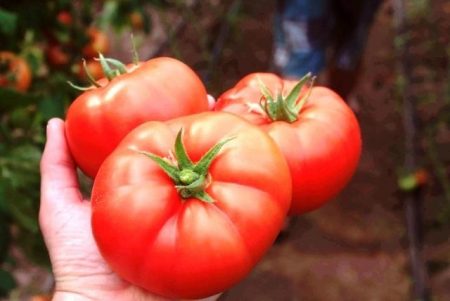 It is difficult to find a summer resident who would not try to grow large tomatoes on his plot. A dream can be realized by planting a Brutus tomato. In addition to its impressive size, the fruits have a great taste.
It is difficult to find a summer resident who would not try to grow large tomatoes on his plot. A dream can be realized by planting a Brutus tomato. In addition to its impressive size, the fruits have a great taste.
Content
General characteristics of the variety
The average ripening period of tomato of this variety and large-fruity suggest growing in most regions in a greenhouse. In the open ground, you can lose part of the crop, as the fruits simply do not have time to ripen before the onset of cold weather. In regions with long and warm summers, for example, in the Krasnodar Territory, the variety grows well in open beds.
Description of the plant and features of the fruit
Bushes of this indeterminate variety reach a height of 1.5 meters. The plant has a powerful main trunk and no less strong shoots. The first flower brush is laid over an 8-9 leaf. The tendency to form lateral stepsons is large.
The variety belongs to large-fruited. Fruits in the first flower brush can reach a mass of up to 1 kg. The subsequent average of 600-800 gr. Tomatoes are rounded, slightly ribbed, at the maturity stage of a bright red color. The pulp is sweet, juicy, sugar on a break with a delicate tomato flavor.
Ripening dates and productivity
The first fruits of Brutus tomato can be tasted in 110-115 days. To reduce the ripening time, you can reduce the number of colors in the brush and the number of brushes themselves. In the same way, you can increase the mass of fruits.
Yields are quite high. With one bush, with proper agricultural technology, you can get up to 5 kg of large fruits.
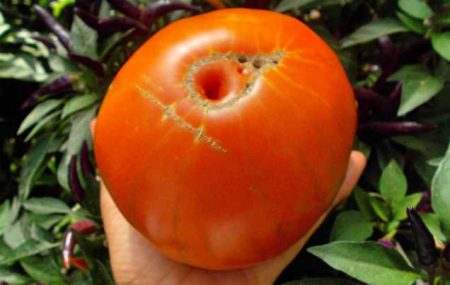
The purpose of the variety
The incomparably delicious weighty tomatoes of this variety are most often grown in order to enjoy them in their natural form or as part of summer vegetable or fruit salads. Thanks to the juiciness and easily detachable skin, it is good to cook tomato juices, pastes, ketchups, dressings from them.
Thin and other peels provide good transportability to the fruit. Therefore, they can be grown for sale. Such handsome tomatoes go to the market in the first place, because the consumer knows about the excellent taste of large-fruited tomatoes. And the price for them is much higher than for small-fruited or medium-fruited relatives.
Agricultural technology
Every seasoned vegetable grower knows that in order to get a good tomato crop, it is important to observe the following key points: determine the correct timing of sowing, choose good seeds, good soil for seedlings and follow the rules of agricultural technology.
Sowing dates
Seeds are sown, focusing on the climatic conditions of their place of residence. In most regions, this time falls on February-March. Seedlings for transplanting into the soil is ready in 60-65 days from germination.
Seed preparation
Of course, you can sow the seeds dry, without any pre-treatment. But many years of experience of vegetable growers show that plants grown from seeds that have been trained begin to bear fruit 1-2 weeks earlier, get sick less and give a much larger crop.
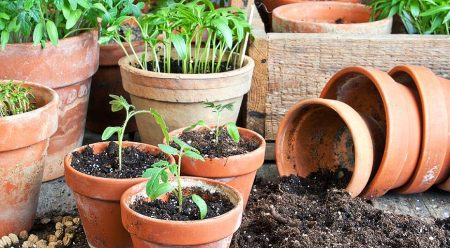
There are many methods for this, we list the main ones that should not be neglected:
Calibration In addition to the known method, lower the seeds in salt water for 20 minutes and discard the pop-up, it is necessary to select the seeds in appearance.From those already treated with saline, seeds of the same size are chosen, with smooth edges and without mold.
Dressing. It is carried out to reduce the risks of fungal and viral diseases. Seeds are soaked in any antiseptic solution. It can be purchased ready-made or prepared independently. The most common are pink manganese solution and light brown iodine solution. They soak the seeds for a day.
Growth stimulation. Increases seed germination, strengthens the resistance and improves the growth of future plants. Today, a large number of ready-made biostimulants are on sale. It’s easy to cook them yourself. For example, soak the seeds in an infused ash solution for 24 hours and filtered (1 tbsp. In a glass of water). A very popular and effective folk stimulant is aloe leaf juice diluted with water one to one. In such solutions, seeds are soaked for a day, during which time they will swell and be ready for planting.
You should know!
You can’t soak dry seeds in potassium permanganate; getting manganese in a dry seed is fatal to the embryo. Therefore, they must first be soaked.
Soil preparation for seedlings
You can prepare the soil for sowing yourself or buy a finished composition. For independent soil preparation you will need:
- land from the forest or from a plot on which nothing has grown for the next 2-3 years;
- peat;
- river sand.
All components are mixed in equal proportions.
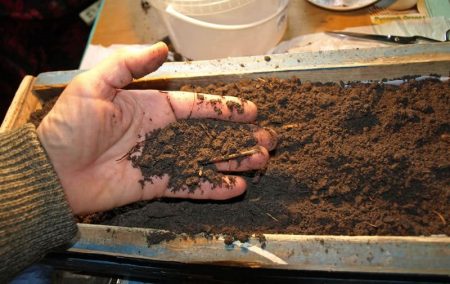
The next step is to disinfect the resulting composition. The easiest and most effective way is to shed the earth first with boiling water, and after a day with a raspberry-colored potassium permanganate solution. Such treatment will kill the pathogenic microflora and will not affect beneficial microorganisms. Disinfected soil must be filled with fertilizers. To do this, add 2 scans of wood ash, 2 matchboxes of superphosphate, 1 tbsp. To a bucket of soil. potassium sulfate and 1 tsp urea.
Seedling Care
Care for tomato seedlings is subject to the following conditions:
- temperature maintenance: in the daytime 18-25 ° C, at night 8-10 ° C;
- humidification of too dry air heating (humidifier or a damp towel on the battery);
- illumination with a short daylight and regular rotation to the light source, for uniform growth;
- watering as the soil dries;
- picking in the phase of 2-3 real leaves.
A week after the seedlings of the tomatoes, you can feed the infusion of ash, for this, one tablespoon of wood ash is dissolved in one liter of water.
Transplant to the greenhouse
Seedlings ready for transplantation should be 25-30 cm high and have 9-10 true leaflets. 2-3 days before planting, the lower leaves of the plants are torn off. Tomatoes are placed vertically in the wells, and they cannot be deeply buried in the soil. Cloudy weather or evening hours are best for transplant activities.
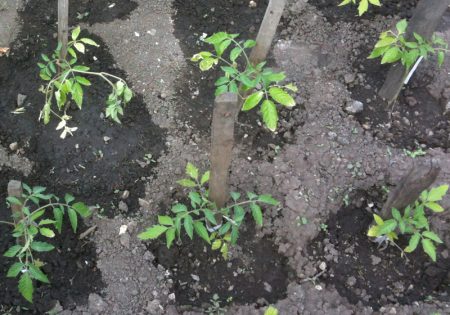
Plants of this variety require sufficient free space for normal growth and fruiting. Therefore, on 1m2 should not be planted more than three bushes. It is best to arrange the tomatoes in a checkerboard pattern in two rows.
Features of plant care in the greenhouse
In addition to watering, weeding and loosening, Brutus plants require garter throughout the entire main shoot. At the same time, the supports should be solid, since the bush with a large number of weighty tomatoes is very heavy. The material for tying should be strong, but soft and wide, so as not to injure the stems of plants.
Another mandatory agrotechnical technique is pinching throughout the season. Otherwise, instead of a large crop of fruits, impassable vines can be obtained.The originator of the variety recommends conducting bushes in one or two trunks. In order to form a tomato in one trunk, immediately after transplantation, all shoots growing from the axils of the leaves begin to be removed. In the second method, in addition to the main stem, one stepson is left for further growth. As a rule, this is a stepson growing under the first brush with flowers.
So that the formation procedure does not damage the tomatoes and does not provoke an infection, the following rules must be observed:
- stepson only in the morning;
- if possible, choose dry and sunny weather;
- when removing the shoot, leave a stump of 1-2 cm;
- after each bush, disinfect the instrument or gloves with potassium permanganate;
- carry out the procedure no more than once a week.
Important!
Tomatoes do not like stagnant air, so the greenhouse must often be ventilated. In the summer, keep the doors of the greenhouse closed only at air temperatures below 12 ° C or during prolonged cold rains.
Advantages and disadvantages of the variety
The positive characteristics of the Brutus tomato include:
- high productivity;
- excellent tastes of fruits;
- large-fruited;
- good transportability of tomatoes;
- the fruits are not prone to cracking;
- strong bush, well holding heavy fruits;
- disease resistance.
The disadvantages of the variety include:
- intended for growing in a greenhouse;
- requires formation and tying;
- not intended for long-term storage.
These disadvantages are not significant, because for long-term storage there are many other less juicy varieties. And the possibility of growing only in a greenhouse, forming and tying up, is rather not a minus, but a feature of this variety.
Diseases and Pests
The variety is immune to major tomato diseases and pests. Provided that the greenhouse and soil in it were disinfected in the spring, the recommended scheme was observed during planting, loosening and weeding are regularly carried out, additional preventive work is not required.
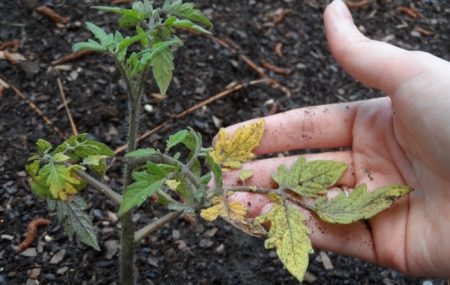
Among summer residents, there is an opinion that the larger the tomato, the more difficult it is to grow it. Tomato varieties "Brutus" this completely refutes. Despite the fact that the manufacturer recommends growing it in greenhouse conditions, according to gardeners, it grows well in open ground and does not require special care. The yield and taste are impressive.
Reviews
Lyudmila, Krasnodar Territory
Great variety! They grow every year on simple ridges, from the scorching sun shaded by a stretched mesh. I always leave only the main stem. But I try to plant more often. One bush produces more than 4 kilograms. I consider this a worthy indicator. Does not crack, tolerates heat well. I feed all tomatoes with tincture of manure with nettles.
Tamara, Kirov region
I liked the variety. Summer was very cold, growing in a greenhouse from old window frames (not very warm) and fruiting remarkably. From one bush I received two very large tomatoes of 800-900 grams, five pieces somewhere in the range of 250-300 grams and a few more small ones. An excellent result for such growth conditions. From my greenhouse it turned out to be the sweetest and sugar. Family all appreciated the novelty.
Ekaterina, Moscow region
The bushes are very powerful and strong, the brush with large fruits holds excellently. Unpretentious, very productive. Unlike many large-fruited fruits, it does not deoxidize, the taste is saturated tomato, not fresh and not sour. My grade is five plus!




 Low-growing tomatoes, without pinching: 5 of the most delicious varieties
Low-growing tomatoes, without pinching: 5 of the most delicious varieties Why tomato seedlings grow poorly
Why tomato seedlings grow poorly We grow a tomato in a shell
We grow a tomato in a shell Growing tomatoes without watering according to the method of Kazarin
Growing tomatoes without watering according to the method of Kazarin